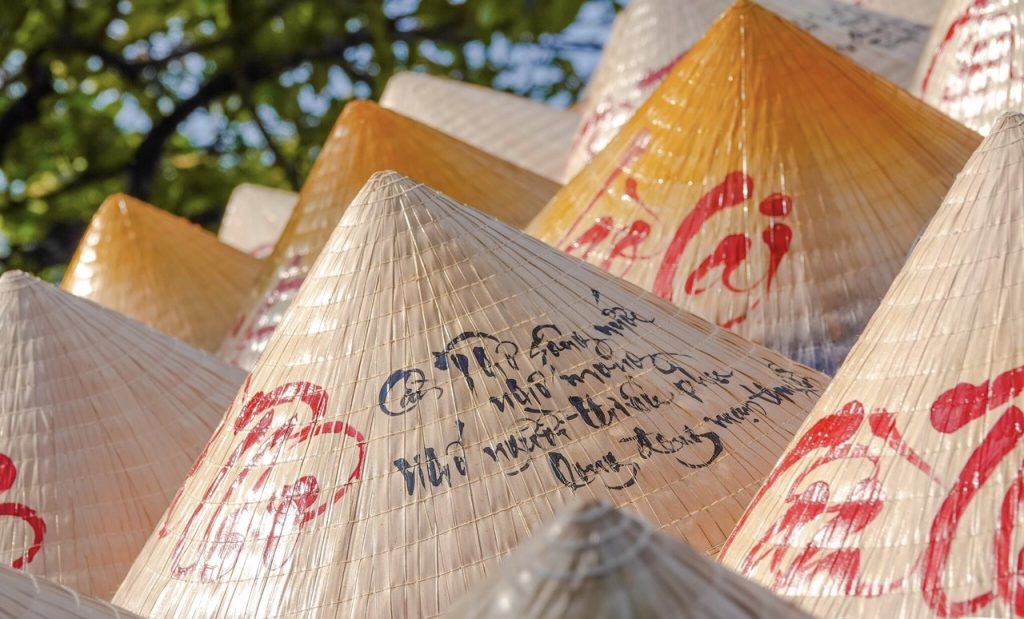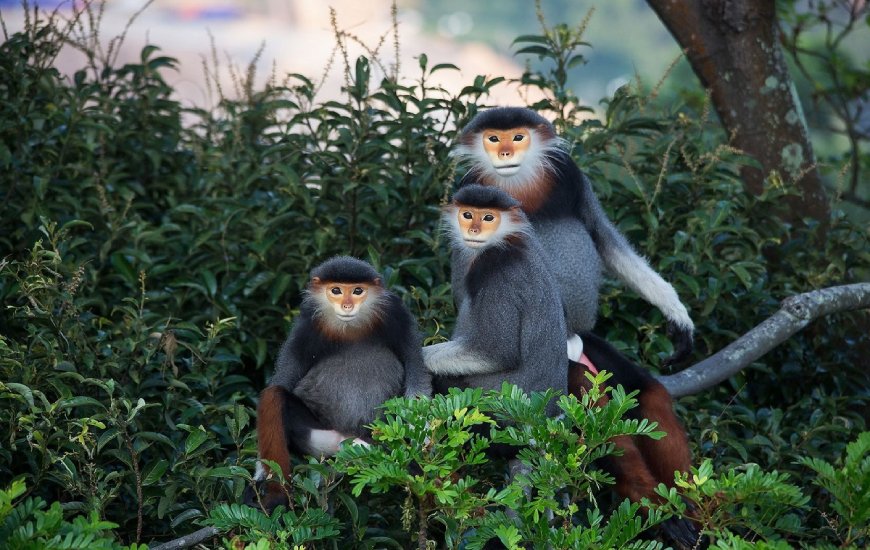Nón Lá Huế: The Story of Vietnam’s Poetic Hat (& Where to Find It)
The Soul of Huế: Unveiling the Magic of the Poem Hat
Ever held a secret in your hands? A secret so delicate it’s woven from sunlight and whispers? In the heart of Vietnam, in the ancient imperial city of Huế, there exists such a marvel. It looks, at first glance, like the iconic conical hat you’ve seen in pictures of Vietnam—a simple, elegant shield against the sun and rain. But lift it to the sky, and something magical happens. The light filters through, and suddenly, poetry appears.
This is the Nón Lá Huế, but more specifically, it is the legendary Nón Bài Thơ—the Poetic Hat. It is the soul of Huế made tangible, an icon of quiet grace and profound beauty that captures the very essence of this romantic city.
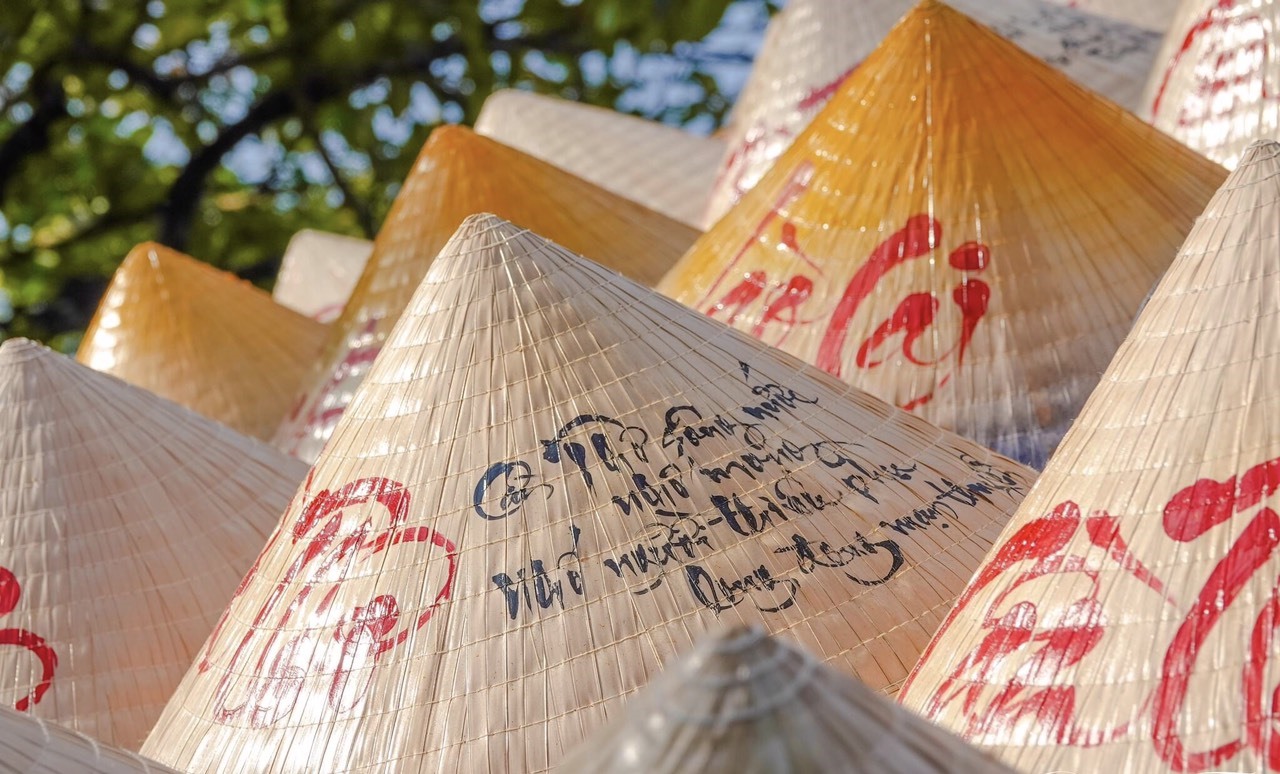
What is the Nón Bài Thơ (Poetic Hat)?
So, what exactly is this enchanting object? The Nón Bài Thơ is a special type of Vietnamese conical hat originating from Huế. Its genius lies in its construction. Between two feather-light layers of palm leaves, an artisan delicately places cutouts of poetry or images. Under normal circumstances, they are completely invisible. But when held against a light source, these hidden verses and silhouettes—often depicting famous Huế landmarks like the Perfume River (Sông Hương) or the Thien Mu Pagoda—are revealed in stunning detail.
It’s not just a hat; it’s a piece of interactive art, a conversation starter, and a tangible link to the poetic soul of Vietnam’s former imperial capital. It represents a subtle and sophisticated form of beauty, one that doesn’t shout but rather whispers, waiting to be discovered.
The Legend Behind the Poem: Who Was Bùi Quang Bặc?
Every great legend has an origin story, and the tale of the Poem Hat is one of artistry and romance. The creation of the Nón Bài Thơ is widely credited to a man named Bùi Quang Bặc, a skilled artisan who loved poetry as much as his craft. Around 1960, he came up with the brilliant idea of embedding verses into the hats he made.
As the story goes, he was inspired by the beauty and grace of Huế women and the poetic landscape of the city. He wanted to create something that would carry the spirit of Huế with it, wherever it went. He began embedding a famous verse that perfectly captured this sentiment:
“Ai ra xứ Huế mộng mơ,
Mua về chiếc nón bài thơ làm quà.”Which translates to:
“Whoever goes to the land of dreams and romance,
Buys a poetic hat as a gift.”
This simple, brilliant innovation transformed the humble conical hat into a celebrated work of art. Mr. Bặc didn’t just create a new product; he wove the city’s identity into an object, creating an enduring symbol that is now recognized worldwide.
More Than an Accessory: The Cultural Symbolism of the Nón Lá Huế
To truly understand the Nón Lá Huế, you have to understand Huế itself. As the former imperial capital, Huế is a city of palaces and tombs, of scholars and poets, of a certain refined and gentle spirit. The Poem Hat is the perfect emblem of this culture. It’s elegant, understated, and holds a hidden depth.
The hat is inextricably linked with the image of the Huế woman, particularly when paired with the Áo Dài Tím (the purple Vietnamese long dress), another icon of the city. The image of a woman in her flowing Áo Dài, her face shaded by a Poem Hat, is the quintessential picture of Vietnamese grace and elegance. The hat is not merely for sun protection; it is a statement of identity, a piece of cultural pride, and a nod to the romantic, literary traditions of the city.
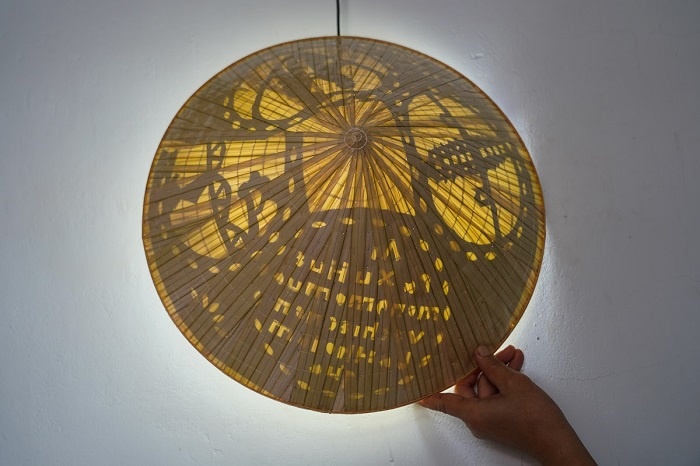
From Leaf to Legend: The Art of Crafting a Poem Hat
Creating a Nón Bài Thơ is a process that requires the patience of a saint and the precision of a surgeon. It’s a craft passed down through generations, a dance of nimble fingers and focused minds. Let’s step into an artisan’s workshop in a quiet Huế village and see how these magical hats come to life.
The Artisan’s Toolkit: Sourcing the Soul of the Hat
You can’t create a masterpiece with subpar materials. The quality of a Nón Bài Thơ begins with the careful selection of its components. The artisans are incredibly particular about this.
- Lá Nón: The leaves are the heart of the hat. Artisans use young, light-green leaves from a specific type of palm tree. They must be harvested at just the right time, then sun-dried and exposed to the evening dew to achieve the perfect pale, almost ivory, color and soft texture.
- Tre (Bamboo): The frame of the hat is made from thin, flexible strips of bamboo, carefully split and polished to be perfectly smooth.
- Chỉ (Silk Thread): The stitching that holds the hat together is done with a fine but strong silk thread, often in vibrant colors, adding another layer of subtle beauty to the finished product.
The 16-Ring Foundation: Building the Frame
The frame, or skeleton, of the hat is known as the *khung* or *vành*. For a classic Huế Poem Hat, this frame consists of 16 concentric rings of bamboo. Why sixteen? There’s a beautiful piece of cultural poetry in that number. In Vietnamese culture, the age of sixteen is considered the peak of a young woman’s beauty, often referred to as “trăng tròn” or the “age of the full moon.” The 16 rings of the hat are a nod to this ideal of youthful grace and perfection, weaving yet another layer of symbolism into its very structure.
Weaving the Magic: The Delicate Process of Inserting Poetry
Here comes the most magical and secretive step. After the first layer of palm leaves is carefully arranged on the frame, the artisan lays down the pre-cut paper cutouts of poems or images. This requires incredible precision. The placement must be perfect so that the final image is centered and clear. Once the artistic layer is in place, a second layer of leaves is placed on top, sandwiching the secret within. It’s a moment of pure artistry, turning a simple craft into a form of storytelling.
The Final Stitches: Sewing the Nón and Finishing Touches
With the layers in place, the meticulous process of sewing begins. This is called *chằm nón*. Using a special needle and the silk thread, the artisan sews the leaves to the bamboo frame with tiny, even stitches that spiral up from the brim to the peak. A skilled artisan can complete a hat in a day, their hands moving in a blur of practiced efficiency. The final touch is the attachment of the colorful silk chin straps, the *quai nón*, which are often adorned with small, decorative beads. The hat is now complete, a vessel of poetry ready to share its secret with the world.
Read more: Visiting Hue Citadel: The Ultimate Guide For 2025 (Tickets, History & Insider Tips)
A Traveler’s Guide: Finding and Buying Your Authentic Nón Lá Huế
Alright, you’re captivated. You’re in Huế, or planning a trip, and you absolutely must have one of these beautiful creations. As your trusted friends at Tuan Travel, we’re here to guide you. Finding a Nón Lá is easy, but finding a truly authentic, well-made Nón Bài Thơ requires a little local know-how.
Where to Witness the Craft: A Guide to Huế’s Hat-Making Villages
For the most authentic experience, go straight to the source! Visiting a craft village is not just about shopping; it’s about seeing the culture in action. A short taxi or motorbike ride from Huế’s city center will take you to these havens of tradition.
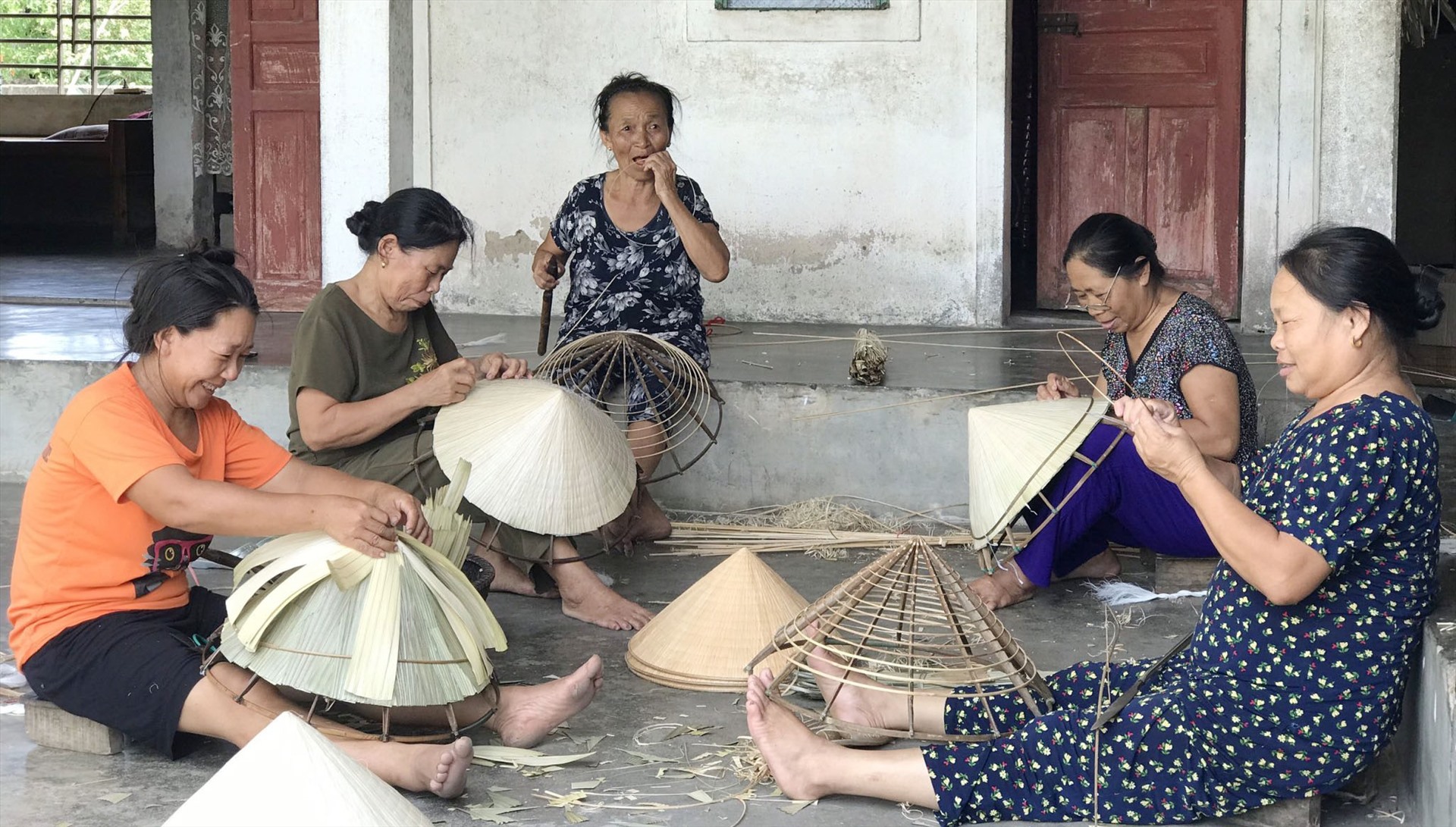
Tây Hồ Village: The Birthplace of the Poem Hat
Located on the picturesque banks of the Như Ý River, Tây Hồ is widely considered the cradle of the Nón Bài Thơ. Here, hat-making isn’t just a job; it’s a way of life. You can wander through the village and see artisans at work on their verandas. Many families will happily invite you in to watch the process up close, and you can buy a hat directly from the hands that made it.
Exploring Beyond: Dạ Lê, Phú Cam, and Other Historic Craft Centers
While Tây Hồ is the most famous, several other villages around Huế specialize in this craft, each with its own subtle variations. Villages like Dạ Lê, Phú Cam, and Đốc Sơ have been making conical hats for hundreds of years. Visiting them showcases the depth and breadth of this regional tradition.
Where to Purchase Your Hat: From Artisan Homes to Bustling Markets
If you don’t have time for a village excursion, don’t worry! You can still find beautiful, authentic hats right in the city.
The Ultimate Hub: Finding Nón Lá at Đông Ba Market
Chợ Đông Ba (Đông Ba Market) is the largest and most famous market in Huế, a chaotic, vibrant, and utterly fascinating place. Tucked among the stalls selling everything from fresh produce to shimmering fabrics, you will find entire sections dedicated to Nón Lá. Here, you’ll see stacks upon stacks of hats in all their glory. It’s a fantastic place to shop, haggle good-naturedly, and soak in the local atmosphere.
How to Choose a Quality Poem Hat: An Expert’s 3-Point Checklist
With so many hats to choose from, how do you pick a good one? Here’s a simple checklist from us to you, ensuring you take home a treasure, not a tourist trinket.
Check 1: The Stitching and Surface
Look closely at the hat. The stitches should be tiny, regular, and even. A sign of high-quality craftsmanship is when you can barely see the knots. The surface of the leaves should be smooth, taut, and free of any blemishes or discoloration. It should feel light but sturdy in your hands.
Check 2: The Poem’s Clarity
This is the fun part! Hold the hat up to a light source—the sky, a window, or even your phone’s flashlight. The hidden poem or image should appear crisp and clear. The edges of the cutout should be sharp, not fuzzy. This indicates that the artistic layer was placed with care.
Check 3: The Price and Authenticity
A well-made Nón Bài Thơ is a piece of art, and its price reflects that. While prices can vary, expect to pay anywhere from 80,000 to 200,000 VND (roughly $3 to $8 USD) for a quality hat at a market or in a village. If a price seems too good to be true, it might be a lower-quality version. Paying a fair price ensures you are supporting the artisans and their incredible skill.
Now that you know the story of the Nón Lá Huế, how it’s made, and where to find it, you might have some more specific questions. This next section explores the finer details and provides a broader context for this unique cultural icon.
Diving Deeper: Your Questions About the Nón Lá Huế Answered
Definitional Question: What is the difference between a standard “Nón Lá” and Huế’s “Nón Bài Thơ”?
This is a great question! Think of it like this: all squares are rectangles, but not all rectangles are squares. Similarly, all Nón Bài Thơ are a type of Nón Lá (which simply means “leaf hat”), but not all Nón Lá are the poetic Nón Bài Thơ. The standard Nón Lá is the classic, unadorned conical hat found all over Vietnam, used for practical sun and rain protection. The Nón Bài Thơ is the specific, artistic variant from Huế that contains the hidden layer of poetry or imagery. It’s the art that makes the difference.
Grouping Question: What are the modern artistic variations of the Huế hat?
The spirit of innovation that Bùi Quang Bặc started is still alive and well in Huế! Artisans continue to experiment, leading to some stunning modern variations. Two notable examples are:
- Nón Trúc Chỉ: This is a high-art version where the hat is made not from palm leaves, but from a special type of artistic paper crafted from bamboo pulp, known as *Trúc Chỉ*. These hats often feature intricate, multi-layered designs and are considered collectible works of art.
- Nón Lá Sen (Lotus Leaf Hat): Another beautiful innovation, these hats are made from treated lotus leaves. The natural vein patterns of the lotus leaf give each hat a unique, organic design, creating a stunning and eco-friendly piece of wearable art.
Comparative Question: How does the Nón Lá Huế compare to conical hats from other regions of Vietnam?
While the conical hat is a national symbol, different regions have their own distinct styles. The Nón Bài Thơ of Huế is known for its elegance, lightness, and of course, its poetic secret. In contrast, the hats from the North, like the famous *Nón Quai Thao* of Bắc Ninh, are often broader and flatter, sometimes with elaborate, tassel-like straps, reflecting different cultural traditions. The hats in the South might be more purely functional and sturdier for work in the Mekong Delta. The Huế hat stands out for its emphasis on art and romance over pure utility.
Boolean Question: Is the Nón Lá exclusively worn by women in Vietnam?
No, it isn’t! While the Nón Bài Thơ, with its poetic and graceful associations, is strongly linked to women, the standard Nón Lá is a practical, unisex item. Travel through rural Vietnam, and you will see it worn by everyone—men and women, young and old—working in the rice paddies, rowing boats, or selling goods at a market. It is a universal tool for life under the tropical sun.
Beyond a Souvenir: The Enduring Legacy of the Nón Lá Huế
As your journey through Huế comes to an end, you might find yourself packing a Nón Bài Thơ to take home. But as you do, remember what you are truly carrying. It’s not just a souvenir. It’s the whisper of a poem from a city of poets. It’s the patient skill of an artisan’s hands, a skill passed down through countless generations. It is a living piece of cultural heritage, a powerful symbol of a city’s gentle soul, and a reminder that the most beautiful things in life often hold a secret, waiting for just a little bit of light to be revealed.
So when you see one, appreciate the craftsmanship. And if you visit our beautiful city of Huế, we at Tuan Travel hope you’ll support the local artisans. By taking home a Poem Hat, you are not just buying an object; you are becoming part of its story and helping to keep a beautiful tradition alive for generations to come.
